Florida is one of the best states in the country for fascinating wildlife and bird life!
With exciting animals like manatees, alligators, and Florida panthers, there is always something new to discover in the Sunshine State.
There are also amazing birds in Florida. You can find spoonbills, orioles, jays, hummingbirds, pelicans, egrets, kites, owls, and so many other species in the state.
Because there is so much water in Florida, thanks to the Atlantic and Gulf Coasts, the Everglades, and a massive system of lakes of rivers, you also have a lot of waterfowl.
Some ducks live in Florida year-round, but even more of them come to the state as part of their winter territory.
In this list, we will tell you about 35 of Florida’s most interesting ducks, ranging from incredibly common to very rare.
Do You Want to Learn to Identify Ducks?
Learning to ID ducks is a fun pastime for new and experienced birders.
There are so many kinds of ducks, and they are often gathered together in small or very large groups.
Being able to distinguish a variety of ducks from one another requires you to quickly spot subtle differences between them. Sometimes, this has to be done at quite a distance, as many ducks are wary of people.
Of course, other ducks are just fine being around people – especially if they live in busy city parks and have plenty of experience with humans.
To identify a duck, you will need to take note of the following characteristics:
- Colors (including feathers, feet, eyes, and bill)
- Patterns (mottled, striped, dappled, patchy, etc)
- Shape (silhouette)
- Size (weight, length, wingspan)
- Migratory habits
- Unique behaviors
- Diet
- Habitat
Keep in mind that many ducks change their appearance in between the breeding and non-breeding seasons, which means it is important to pay attention to when a photograph of a duck was taken before trying to use it for identification purposes.
Types of Ducks: Dabbling, Diving, and More
Ducks can be divided into two main groups: dabblers and divers.
Dabbling ducks dunk their heads underwater to access their food, but they do not submerge themselves completely. In fact, you’ll often see their little tailfeathers sticking up into the air as they stretch their necks below the water for food.
Diving ducks, on the other hand, submerge themselves completely beneath the surface. Usually, they dive about 10-50 feet, but some ducks, like the record-breaking Long-Tailed Duck, will dive as deep as 200 feet under the water!
Sea ducks are a subcategory of diving ducks. They live almost exclusively in the ocean and deep saltwater environments. We identify the sea ducks in this list but remember that they are also diving ducks.
Whistling ducks are the last category of duck on our list. They used to be called “tree ducks,” but that category is now defunct.
Let’s get started with the 35 ducks you may see in Florida!
American Black Duck (Dabbling Duck)
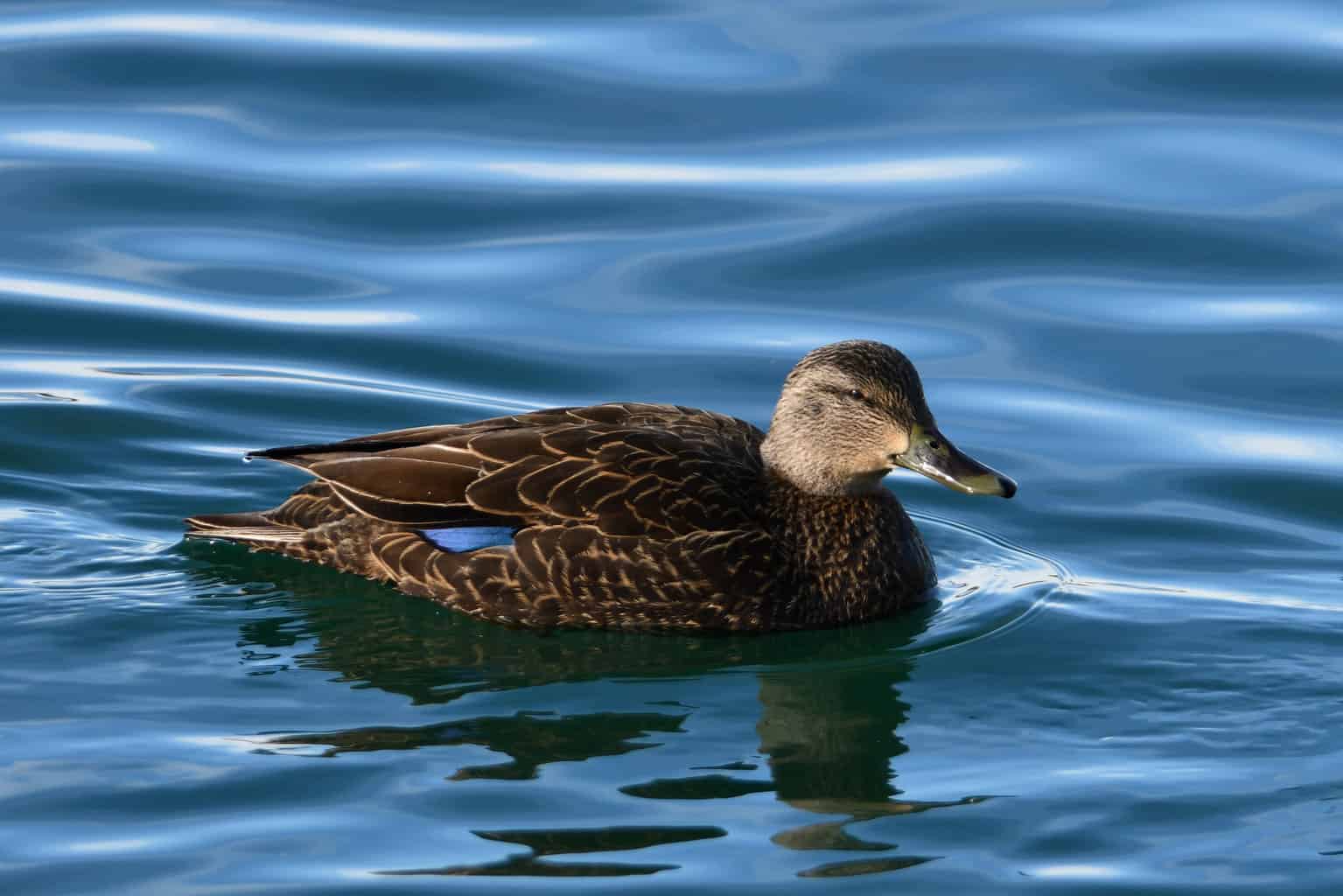
- Anas rubripes
- Length: 21.3-23.2 inches
- Weight: 25.4-57.9 ounces
- Wingspan: 34.6-37.4 inches
You will only find American Black Ducks in the eastern half of North America. They breed in eastern Canada, live year-round in New England and the Great Lakes Region, and winter in the Midwest and South.
Their presence in Florida is typically limited to the northern half of the state.
The male American Black Duck can be identified by his dark brown body and bright blue speculum, which is a bar of color found on many ducks’ secondary wing feathers.
A speculum is easier to see when the duck is in flight, as it is somewhat hidden when the duck is standing, sitting, or swimming.
The male Black Duck looks a lot like a female Mallard. If you can spot a female Mallard, you can probably identify a male Black Duck.
Look for the same large pattern in dark and light brown, but then check the bill color. The male Black Duck’s bill is yellow, whereas the Mallard female’s bill is orangeish-gray.
Females are a lighter brown version of the male with a green bill.
Deforestation is causing some stress to American Black Ducks, who prefer wooded habitats like inland marshes, rivers, ponds, and lakes.
American Wigeon (Dabbling Duck)

- Mareca americana
- Length: Up to 14 inches
- Weight: About 2.25 pounds
- Wingspan: 34 inches
All of Florida is included in the American Wigeon’s winter range, which stretches down the eastern US coast, across most of the southern US and Mexico, and along the Pacific Coast.
They are found in a variety of winter habitats: lakes, ponds, brackish marshes, and saltwater marshes. As long as there is plentiful aquatic vegetation in the area, they will usually find it hospitable.
The male American Wigeon has earned the nickname of “baldpate,” thanks to his bright white crown that contrasts the rest of his brown head and body.
He also has an iridescent green patch over his eyes that extends down the back of his head. His wings have black tips, and he has a blueish-gray bill.
Females are light brown with a dappled gray head. The female has dark eyes.
Both males and females have black-tipped bills.
Black-Bellied Whistling Duck (Tree Duck/Dabbling Duck)

- Dendrocygna autumnalis
- Length: 19 – 22 in (47 – 56 cm)
- Weight: 652 – 1020 g (1.437 – 2.249 lb)
- Wingspan: 30 – 37 in (76 – 94 cm)
Black-Bellied Whistling Ducks have been inhabiting Florida regularly since 1968. They live year-round in the Florida peninsula but you are unlikely to see them in the panhandle.
These ducks “whistle” when they are flying, swimming, or standing.
As one of the rare sexually monomorphic ducks in North America, both male and female Black-Bellied Whistling Ducks have the same appearance.
The male and female each have a great head with a dark brown crest, a brown breast, and a gray face. Their bills are pink and their bellies are black.
They don’t really build their own nest; rather, they situate themselves in piles of debris or empty tree cavities and take advantage of whatever is already there.
Black Scoter (Diving Duck)
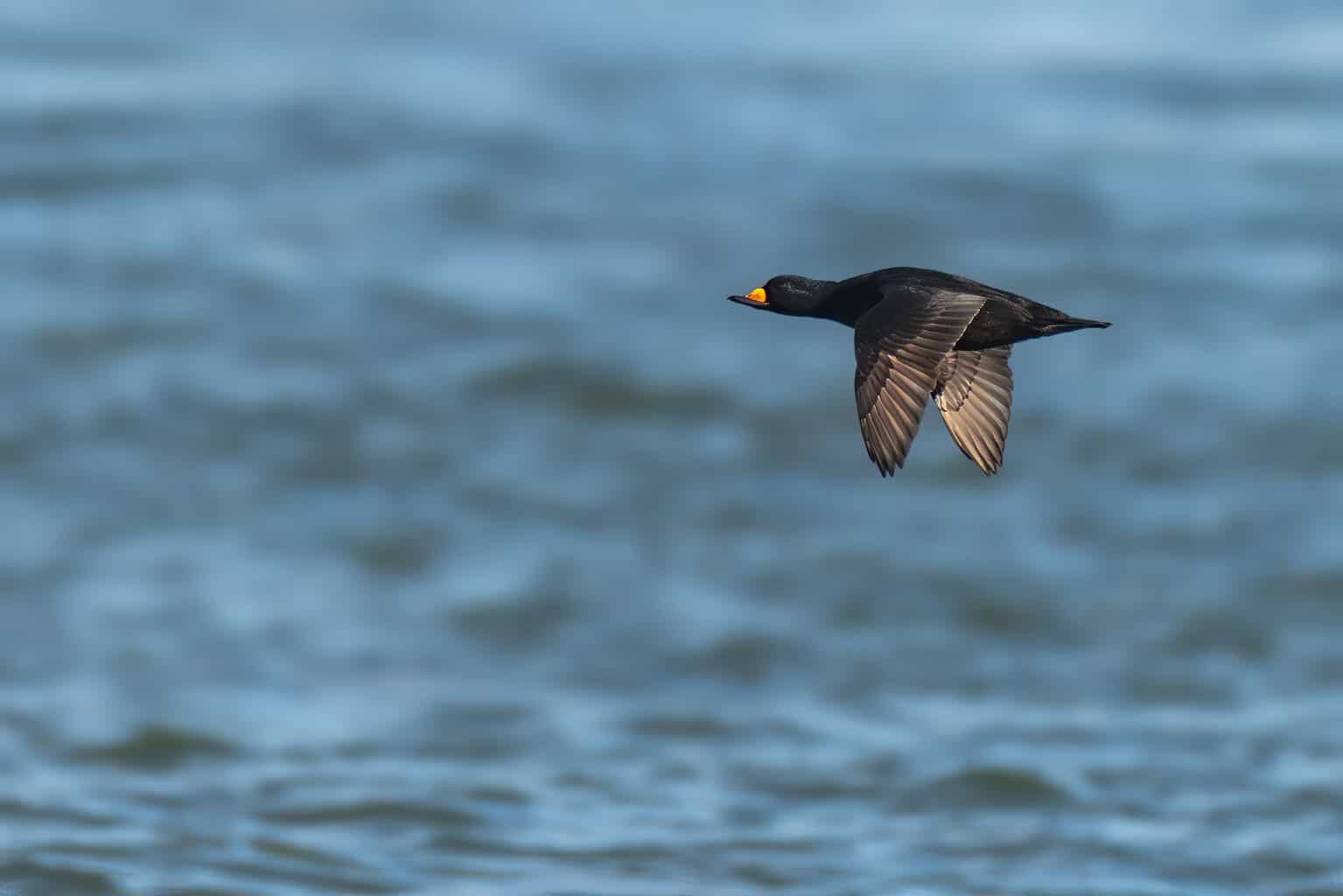
- Melanitta Americana
- Length: 127 – 21 in (43 – 53 cm)
- Weight: 387.4 oz (1088 g)
- Wingspan: 30 – 35 in (76 – 89 cm)
In the Eastern part of the US, Black Scoters winter along the Atlantic and Gulf Coasts. However, they are not usually seen in Florida any further south than Dixie County in the west and Brevard County in the east.
The male Black Scoter is immediately recognizable, thanks to the orange bulge at the base of his bill. Aside from his orange bill, he is all black, including his eyes and legs.
Females are mottled in light brown, but their crown is dark brown. The female has gray cheeks and an all-black bill.
Blue-Winged Teal Duck (Dabbling Duck)
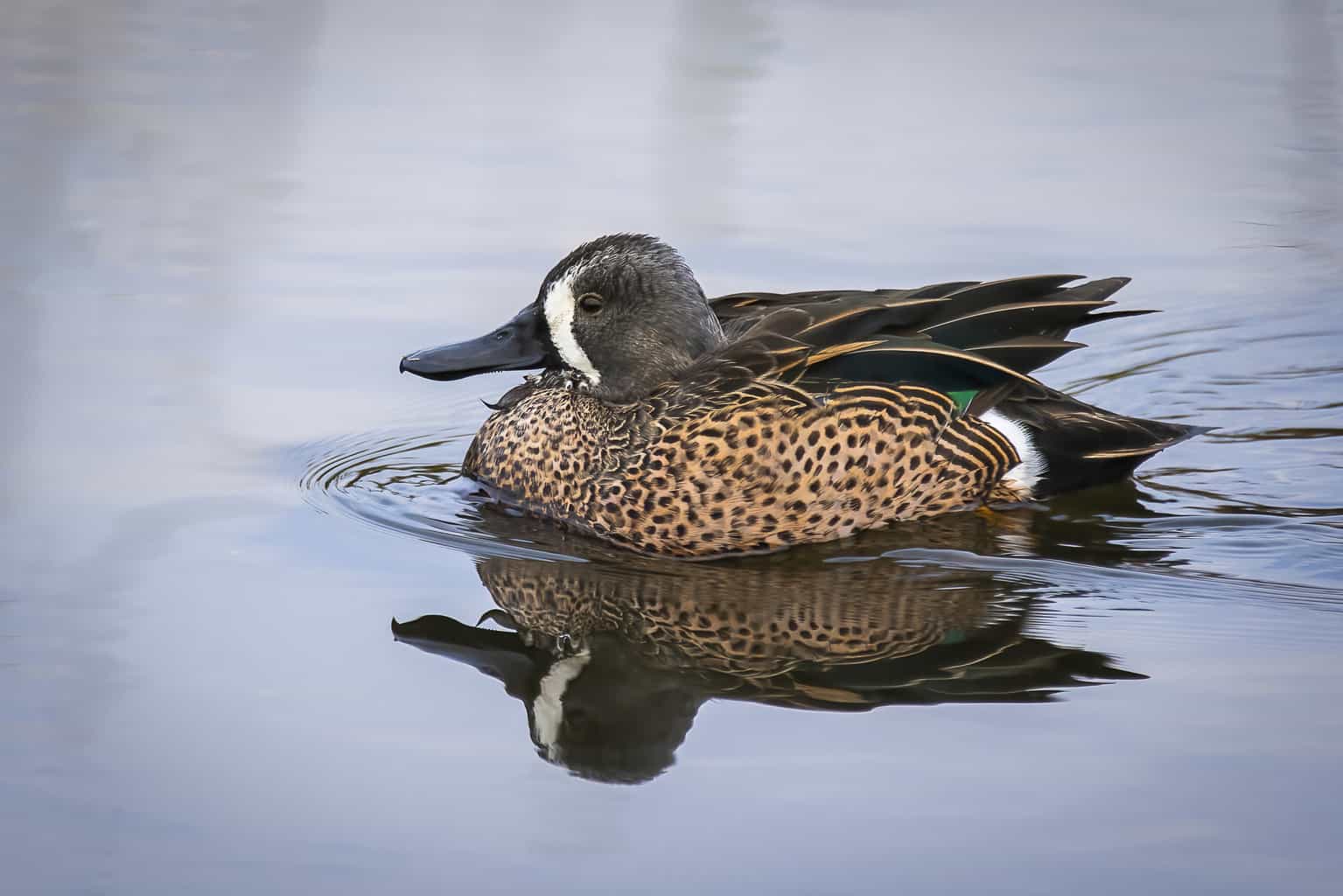
- Spatula discors
- Length: 15 – 17 in (38 – 43 cm)
- Weight: 19.18 oz (544 g)
- Wingspan: 23 -31 in (58 – 79 cm)
Blue-Winged Teal Ducks are rare nesting residents of Florida. They are much more common in the winter in grassy ponds and calm marshes.
To identify a male Blue-Winged Teal Duck, look for his gray head, mottled brown body, and the large, white crescent-shaped patch in front of his eyes. His speculum is green and he has a blue shoulder patch.
Females don’t have any distinctive markings on their face. They are brown-bodied with speckles all over. Both sexes are small ducks who eat a diet that mostly consists of seeds.
Blue-Winged Teal Ducks have unfortunately high mortality rates, which researchers believe is related to how far they migrate every year. They will travel all the way between Canada and South America twice a year.
Bufflehead (Diving Duck)

- Bucephala albeola
- Length: 13 – 16 in (33 – 41 cm)
- Weight: 21.16 oz (600 g)
- Wingspan: 22 in (55.8 cm)
Buffleheads spend the winter in northern Florida. They are found in the region’s inland ponds, and sometimes in protected coves along the coast.
As cavity-dwellers, they are also amenable to staying in nest boxes, which you can actually build on your own pretty easily!
Male and female Buffleheads earn their name from their large, fluffy heads. The male’s head is particularly flashy in a big, color-block pattern of white and iridescent green and purple. The female’s head is dark gray, and she has a white patch on each cheek.
If you have a chance to see a Bufflehead walking around on land, it can be a funny sight! The legs of these small ducks are set far back on their body, which means they are a bit clumsy.
Canvasback (Diving Duck)
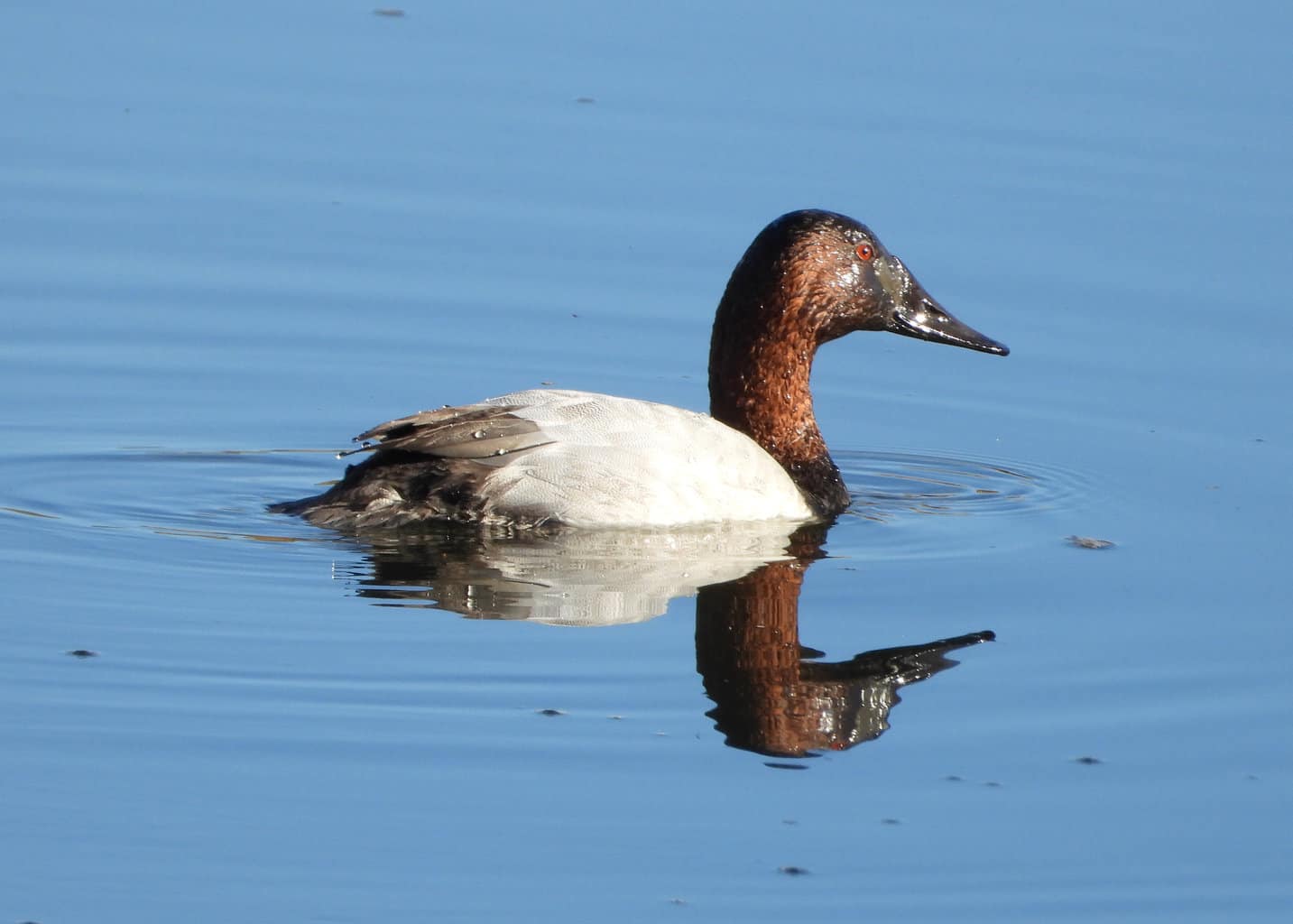
- Aythya valisineria
- Length: 19 – 24 in (48 – 61 cm)
- Weight: 58.48 oz (1657 g)
- Wingspan: 28 – 36 in (71 – 91 cm)
Canvasbacks are regular winter residents of Florida, where they settle into ponds and marshes. Two places where they have recently been photographed are Apopka Lake and Viera Wetlands.
The Canvasback is the largest diving duck in North America. The male’s reddish-brown head boasts a large, sloping forehead. Most of his body is canvas-gray, and he has a thick black bill, red eyes, and a black tail.
Females have similar patterning to males but in more muted colors. They have red eyes instead of black ones.
Their diet consists of large amounts of wild celery, which is a native plant in Florida. One of the best ways to find Canvasbacks is to pay attention to where this plant grows.
Cinnamon Teal Duck (Dabbling Duck)

- Spatula cyanoptera
- Length: 11 inches
- Weight: 12.6-18.2 ounces
- Wingspan: 25 inches
Cinnamon Teal Ducks are rare visitors to Florida, but there are usually a few in the state every winter, including on Merrit Island.
The male Cinnamon Teal Duck is much more colorful in the summer than in the winter when he is in Florida.
His breeding season appearance features a dark, rusty-brown head and neck, black primary feathers, and green secondary feathers. During the winter, he has faded coloring and looks much like the female.
Females are coarsely mottled in dark and light brown. She has a thick, black bill.
Common Eider (Sea Duck)
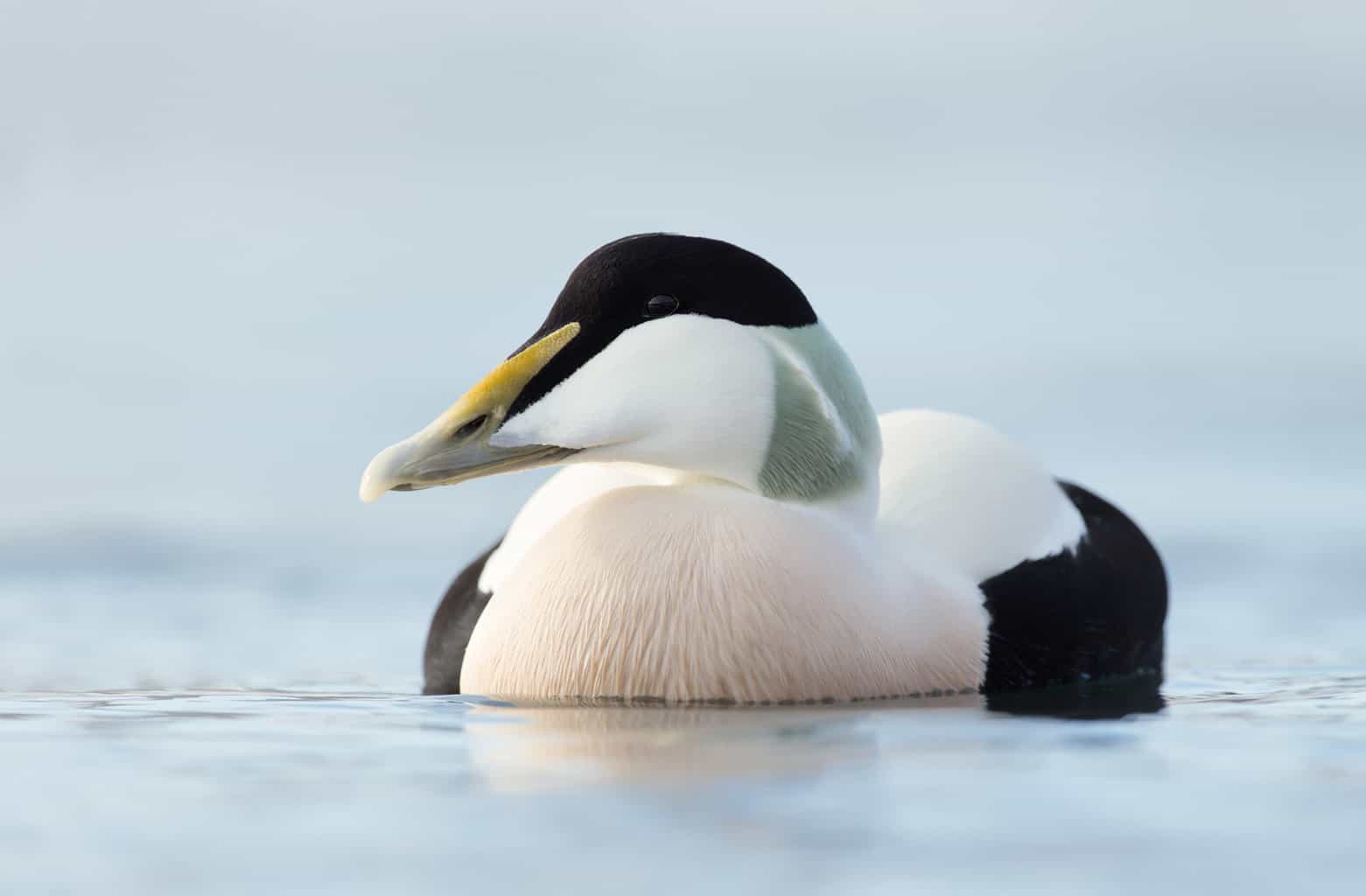
- Somateria mollissima
- Length: 19.7-28.0 in (50-71.1 cm)
- Weight: 45.9-92.1 oz (1300-2611 g)
- Wingspan: 37.4-38.6 in (95-98 cm)
Common Eiders are rare winter visitors in Florida. Their breeding range is along the Arctic Ocean and Hudson Bay. Their non-breeding range extends down the Atlantic Coast, and some individuals end up making it all the way to Florida.
The male Common Eider is very large. He is black and white, with some light green coloring on the back of his neck. The color of a male’s bill can vary – some individuals have a greenish bill, while others are yellowish-orange. He has a black crown from his eyes to the top of his head.
The immature male is brown, as is the female. The biggest difference is that he will have white patches all over, but she will not.
The female Common Eider has dark brown and black barring on her body.
Eiderdown is in high demand for down-filled clothing, coats, pillows, etc, as it is incredibly soft and an excellent insulator.
It is still collected from Common Eider nests in the summertime, but only in Canada and Iceland. Strict international and national laws govern the harvesting of Eiderdown to avoid harming these ducks.
Common Goldeneye (Sea Duck)

- Bucephala clangula
- Length: 16-20 inches
- Weight: Approximately 1.8 pounds
- Wingspan: 30.3-32.7 inches
Common Goldeneyes spend the winter in most of the US after breeding across Canada. One of the only areas that they avoid is the US southeast and inland Florida. However, they are found along the Atlantic and Gulf Coast, but only in the northern part of the state.
Common Goldeneye males are usually pretty easy to identify. The male’s head is iridescent green, and his body is black and white. His eyes are yellow, and he has noticeable white patches on his wings.
Female Common Goldeneyes have brown bodies and black bills that are tipped in yellow.
They both have yellow-gold eyes.
Because Common Goldeneyes are so aggressive toward one another, they sometimes end up raising their young in accidental “creches.” Essentially, females will fight, and their ducklings will scatter.
They may or may not find their original mother duck, but they will usually find their way back to one nest or another. They are raised alongside ducklings from other nests.
Common Merganser (Sea Duck)

- Mergus merganser
- Length: 22 – 27 in (56 – 69 cm)
- Weight: 60.8 oz (1723 g)
- Wingspan: 31 – 37 in (79 – 94 cm)
Common Mergansers spend the winter on the Atlantic Coast, all the way from Newfoundland down to the northern edge of Florida. Technically, Mergansers are sea ducks, but they also live on freshwater lakes.
The Common Merganser male has a dramatic, iridescent green head, white belly, black eyes and back, and a long, bright red bill. The female’s head is reddish-brown with a shaggy crest. Her back and belly are both gray, and she has a white breast.
The serrated bill of the Common Merganser is used to tear apart the flesh of the fish, frogs, worms, and mollusks that make up their diet.
You may be able to see Common Mergansers alongside Buffleheads, as they have similar habitat preferences.
Eurasian Wigeon (Dabbling Duck)
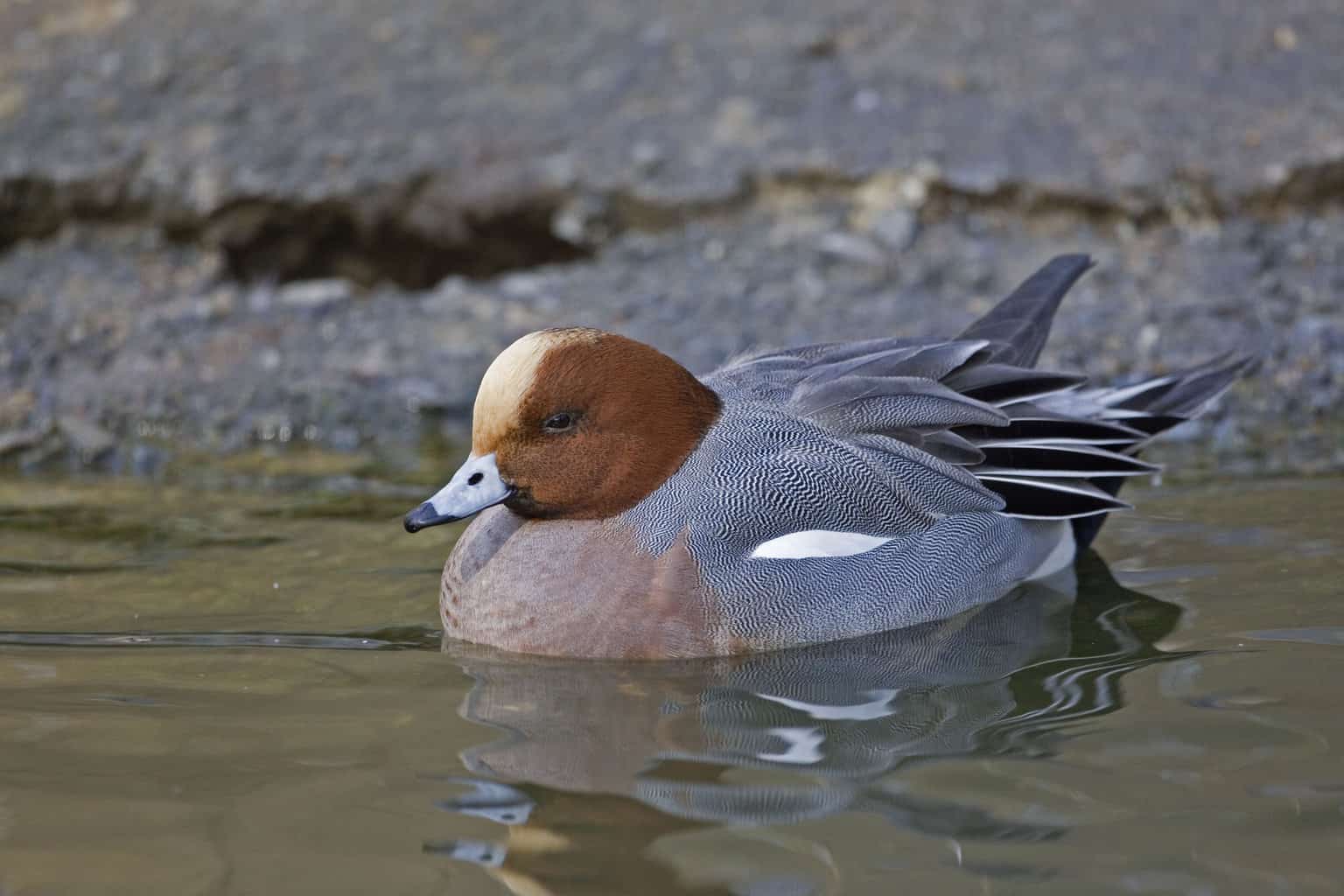
- Mareca penelope
- Length: 17-20 inches
- Weight: 1.102-2.366 pounds
- Wingspan: 28-31 inches
Even though Eurasian Wigeons are rare in North America because they spend most of their time across Russia, Europe, and China, some individuals do migrate all the way to the United States for the winter. One of the only states they visit is Florida.
Male Eurasian Wigeons have a rufous head with a beige forehead and a light brown chest. The male’s body is gray, and he has a gray bill with a black tip.
Female Eurasian Wigeons are dark brown with a light-colored belly and dark markings across their backs. Her bill looks just like his.
Watch for Eurasian Wigeons amidst groups of American Wigeons, especially on large lakes.
Fulvous Whistling-Duck (Tree Duck/Dabbling Duck)
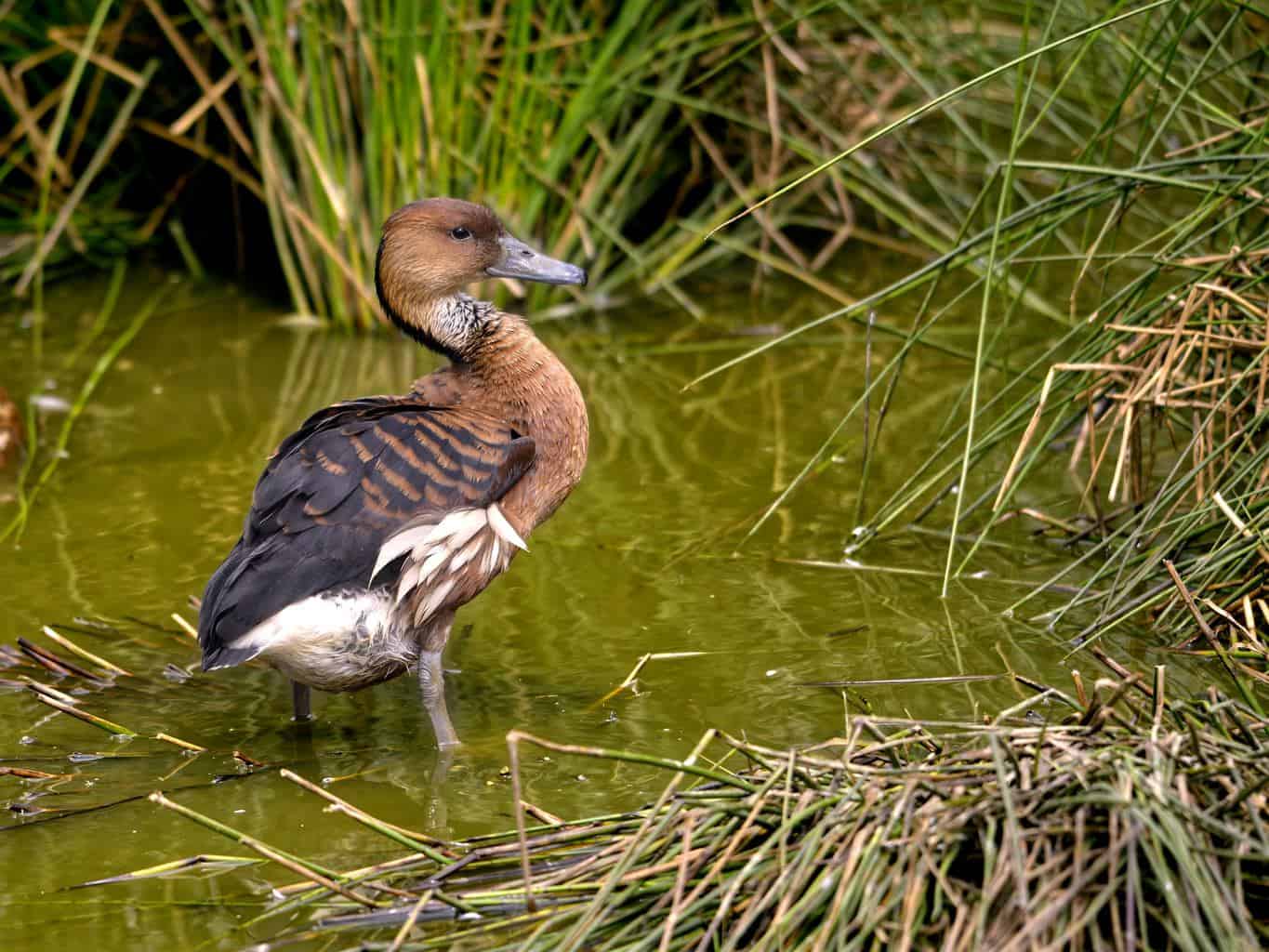
- Dendrocygna bicolor
- Lenth: 18 – 21 in (45 – 53 cm)
- Weight: 25 – 37 oz (1.5 – 2.3 lb)
- Wingspan: 33 – 40 in (83 – 101 cm)
Fulvous Whistling-Ducks are a common breeding species in Florida, although they only started staying here about 30 years ago.
They live in the state’s freshwater wetlands. Fulvous Whistling-Ducks are also found around the world, including in Africa, South America, and Asia.
Fulvous Whistling-Ducks are sexually monomorphic, so males and females look just alike. They both have caramel-brown bodies, black stripes on their backs, and long necks and legs.
They are filter feeders, which means they scoop up water with their bills and let it strain out of their mouths.
Gadwall (Dabbling Duck)
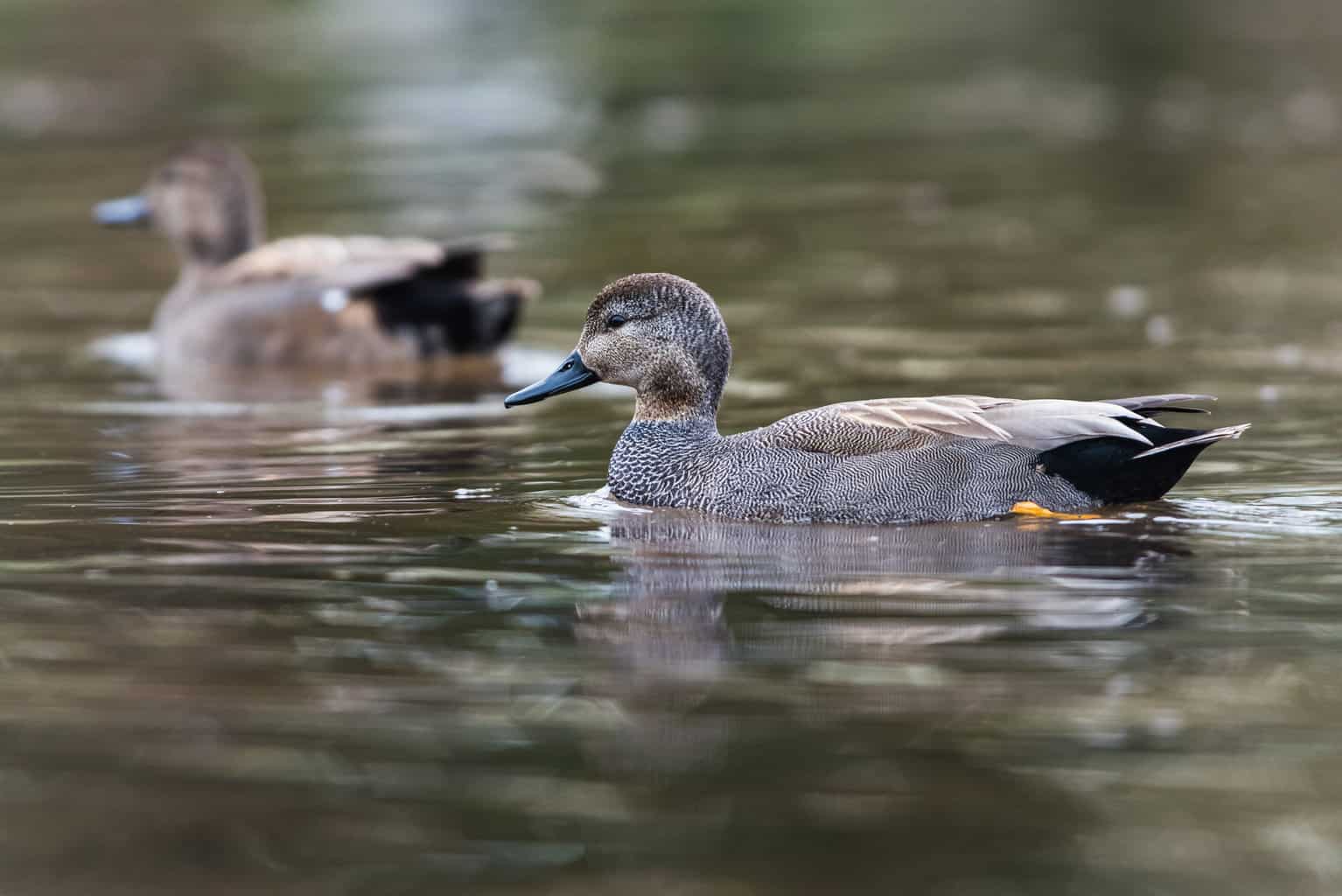
- Mareca strepera
- Length: 19 – 23 in (48 – 58 cm)
- Weight: 35.27 oz (1000 g)
- Wingspan: 31 – 36 in (79 – 91 cm)
Gadwall are year-round residents of Florida, but they are much more common in the fall and winter.
In the summer, you will find them in marshes, ponds, and small lakes. In the winter, they move to reservoirs and ponds, as well as both fresh and saltwater marshes. They will also visit city parks and sewage ponds.
Male Gadwall have a delicate scalloped pattern over their body. They have black tails and bills, and a dappled, gray-brown head.
Females have a much larger pattern in both light and dark brown. They have an orange bill.
Both sexes have white marks on their wings.
Gadwall eat lots of aquatic plants, including shoots, nuts, grains, bald cypress, and buttonbush. They also eat invertebrates.
Greater Scaup (Diving Duck)
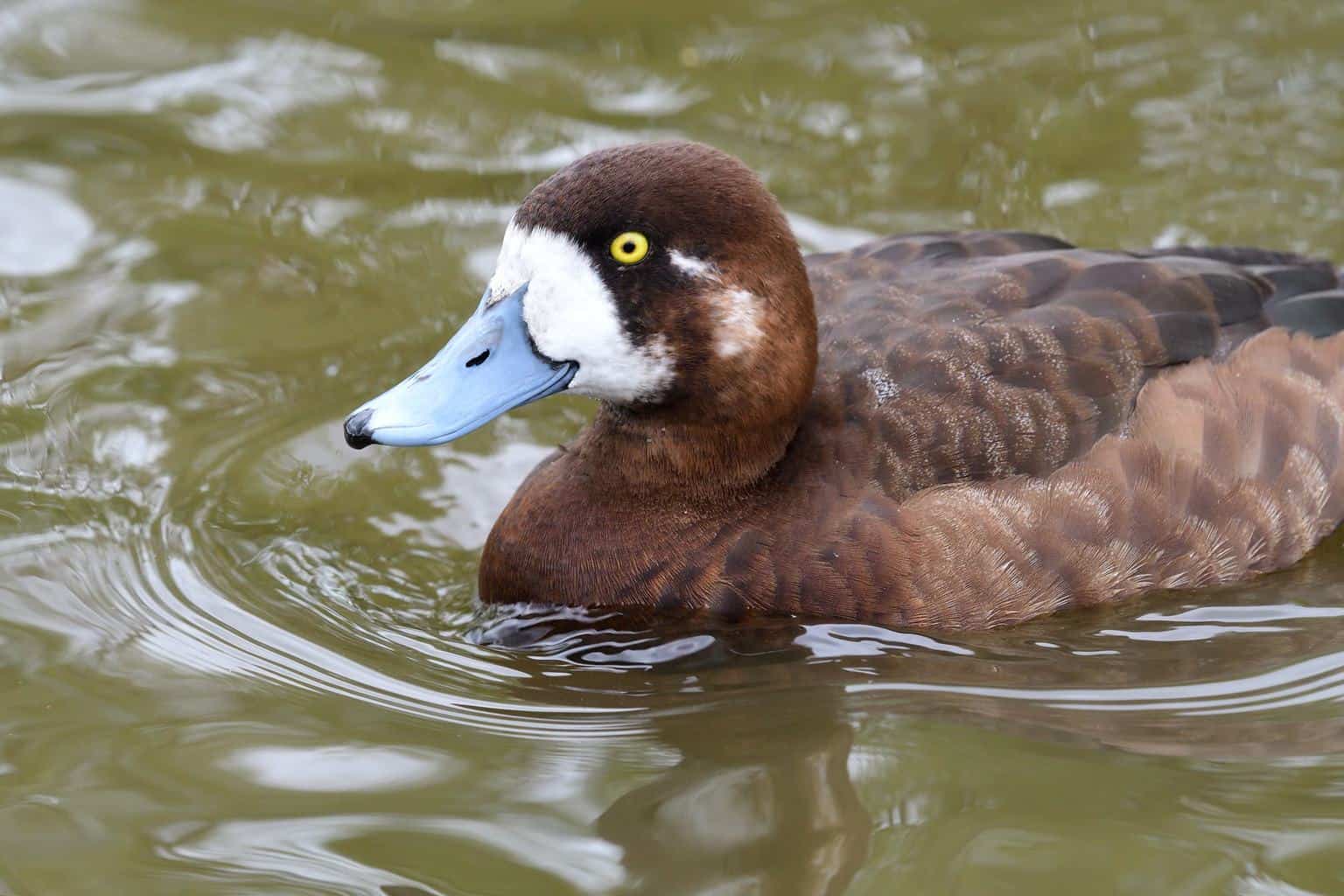
- Aythya marila
- Length: 15-22 inches
- Weight: 1.5-2.9 pounds
- Wingspan: 28-33 inches
Greater Scaup are not found in most of Florida, but you may see them in the Panama City area during their migration periods. They stop on large, shallow lakes when they migrate between their breeding and winter territories.
The male Greater Scaup is predominantly white, with black and brown barring across his back. His head is iridescent green during the breeding season, but his winter coloring is much less vibrant.
Females don’t have very distinctive markings. The female’s head is dark brown, and her body is mostly light brown. She has a thick pale ring around the base of her bill.
Green-Winged Teal Duck (Dabbling Duck)
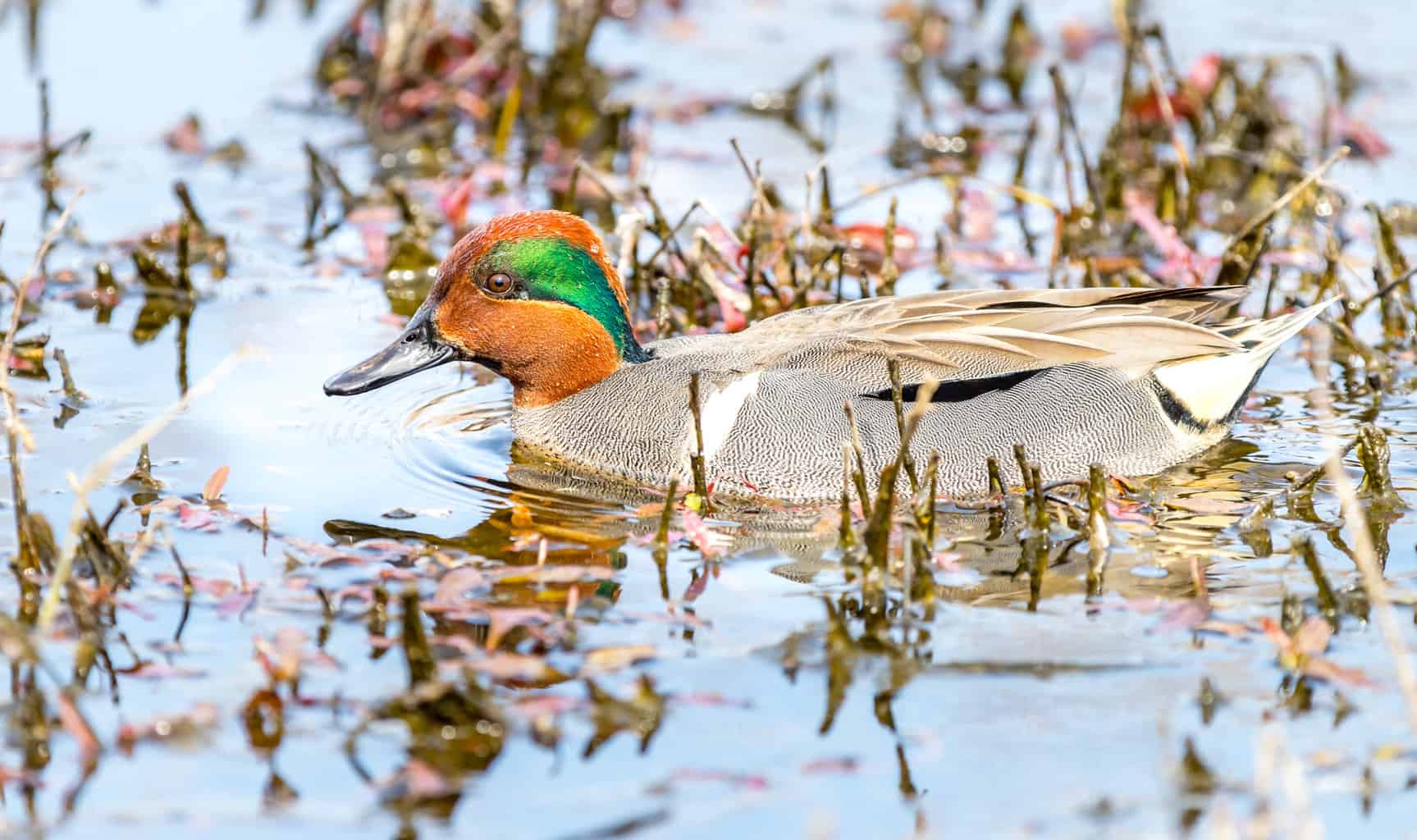
- Anas crecca
- Length: 12.2 – 15.3 in (31 – 39 cm)
- Weight: 4.9 – 17.6 oz (140 – 500 g)
- Wingspan: 20.5 – 23.2 in (52 – 59 cm)
The tiny Green-Winged Teal winters throughout Florida, both inland and along the coast. Their preferred habitats include coastal estuaries, shallow lakes, inland ponds, and tidal marshes. They tend to live along waters where there is a lot of floating vegetation.
Male Green-Winged Teal Ducks are gray-bodied and have chocolate-brown heads. He also has an iridescent green stripe over his eyes and a green speculum on his wings.
Immature males and females look about the same; both are light and dark brown. The female has a yellow streak on her tail feathers.
Green-Winged Teal Ducks are among the smallest ducks in North America. They can also take off directly from the water, without needing a running head start.
Harlequin Duck (Sea Duck)
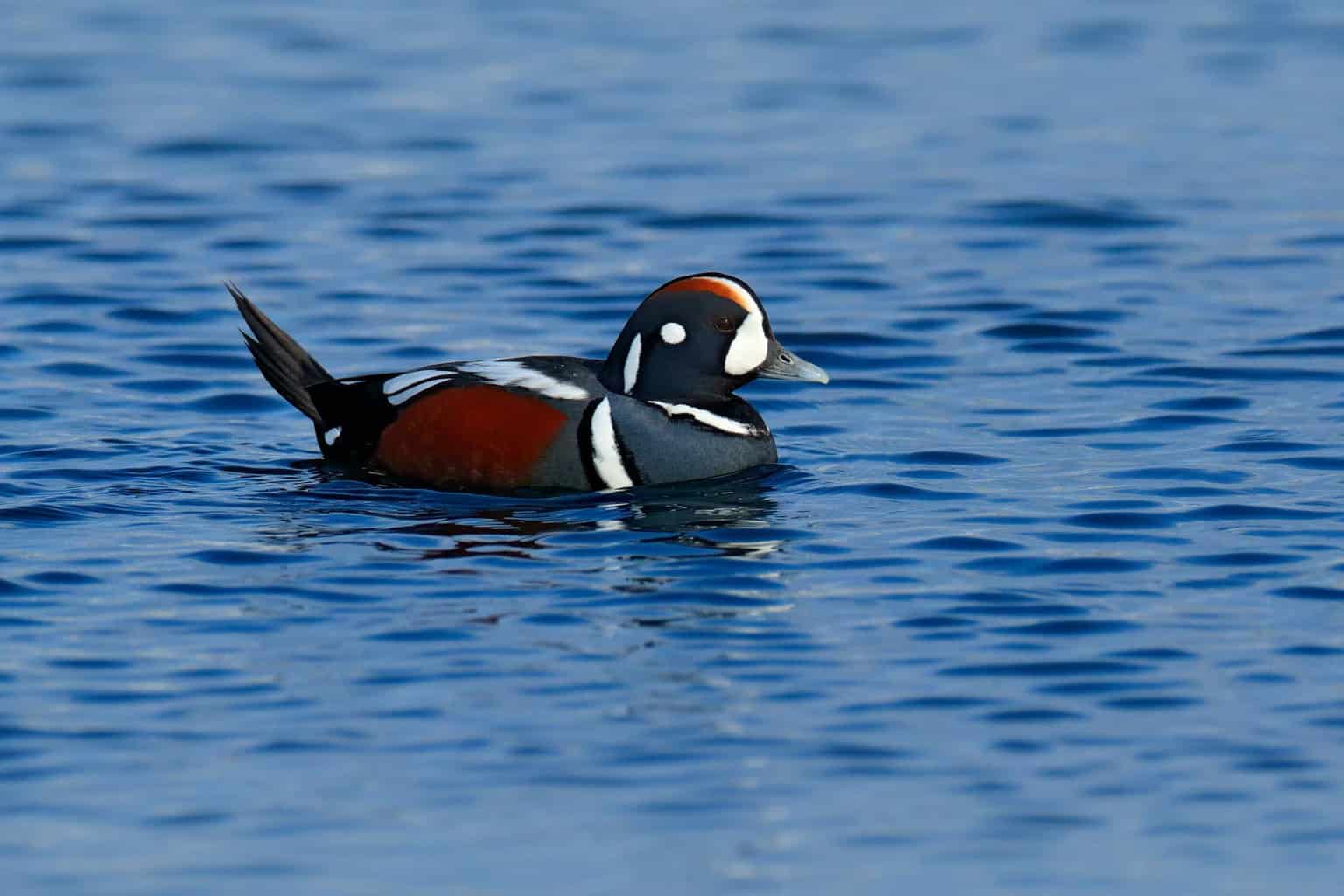
- Histrionicus histrionicus
- Length: 15 – 21 in (38 – 53 cm)
- Weight: 24 oz (680 g)
- Wingspan: 26 – 28 in (66 – 71 cm)
Florida is not part of the Harlequin Duck’s typical range, but some individuals do show up here on occasion.
Male Harlequin Ducks are beautiful, small ducks that are mostly slate blue, but they have extravagant patterns all over their body.
They have black-outlined stripes on their neck, chest, and head. A chestnut brown stripe tops his head, which matches the chestnut patches on his sides and under his wings.
Females are much less dramatic. They are all dark brown with a small white patch on the base of their neck.
Harlequin Ducks are nicknamed the Sea Mouse, which is an adorable name for such a small duck. They get this nickname from their mouse-like vocalizations.
Hooded Merganser (Sea Duck)
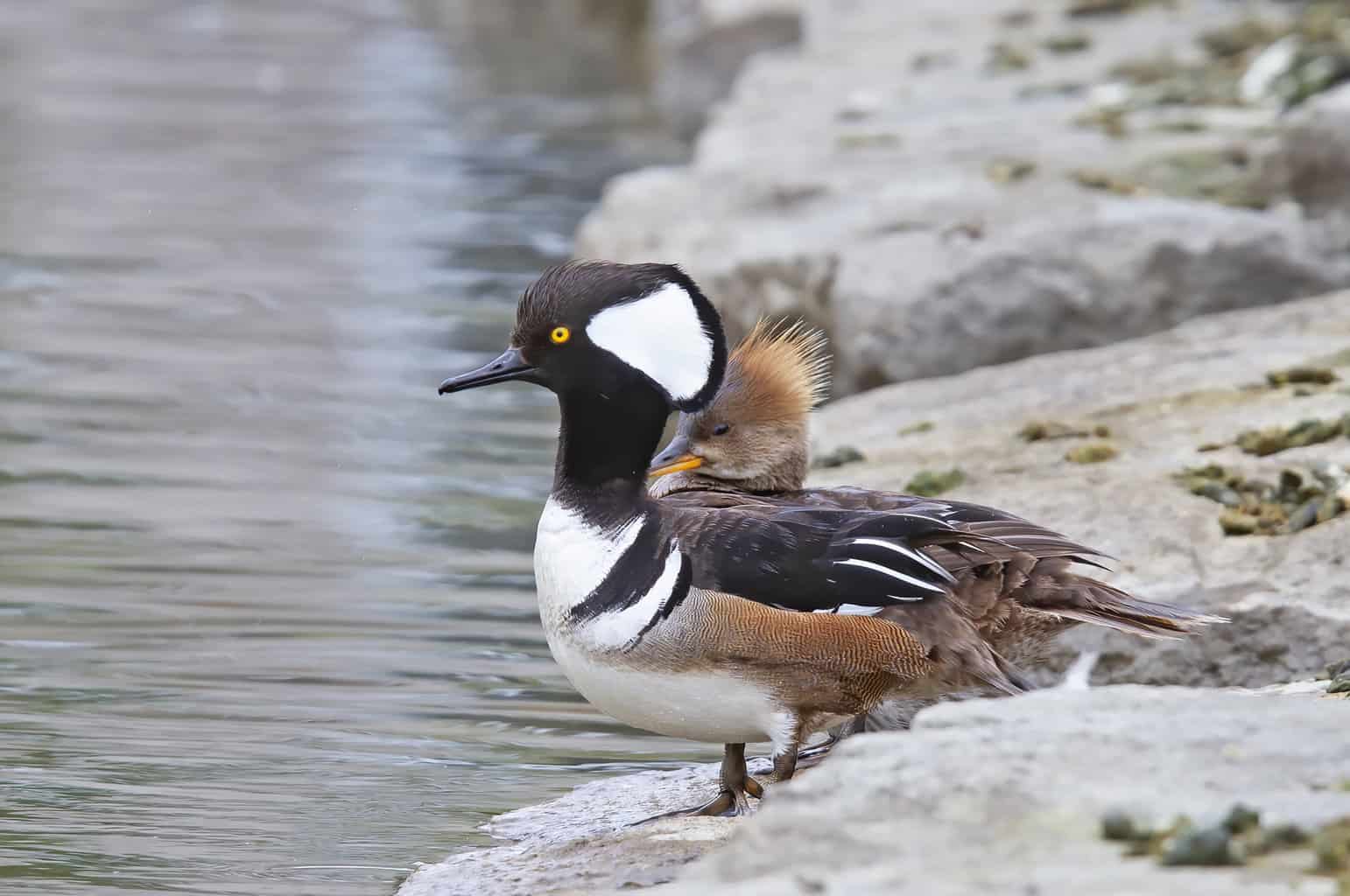
- Lophodytes cucullatus
- Length: 16 – 19 in (41 – 48 cm)
- Weight: 32.09 oz (909 g)
- Wingspan: 24 – 26 in (61 – 66 cm)
Hooded Mergansers are among the rarest breeding season ducks in all of Florida. They breed in wooded lakes, ponds, and rivers. Even so, they are quite common in Florida all winter long, when they inhabit wooded swamps and both fresh and brackish estuaries on the coast.
You can identify the male Hooded Merganser by his black and white crest, which he can lower and raise at will. When it is raised, it is shaped like a large fan, but when he lowers it, his crest becomes a small stripe of white.
His body is black and white, except for his sides, which are brown. He has a black bill.
The female Hooded Merganser has a shaggy crest in cinnamon brown, like the rest of her head. She lacks any distinctive markings, although some females do have some orange on their black bills.
Hooded Mergansers are nicknamed the “frog duck” because they have a croak-like vocalization that sounds like a pickerel frog.
King Eider (Sea Duck)
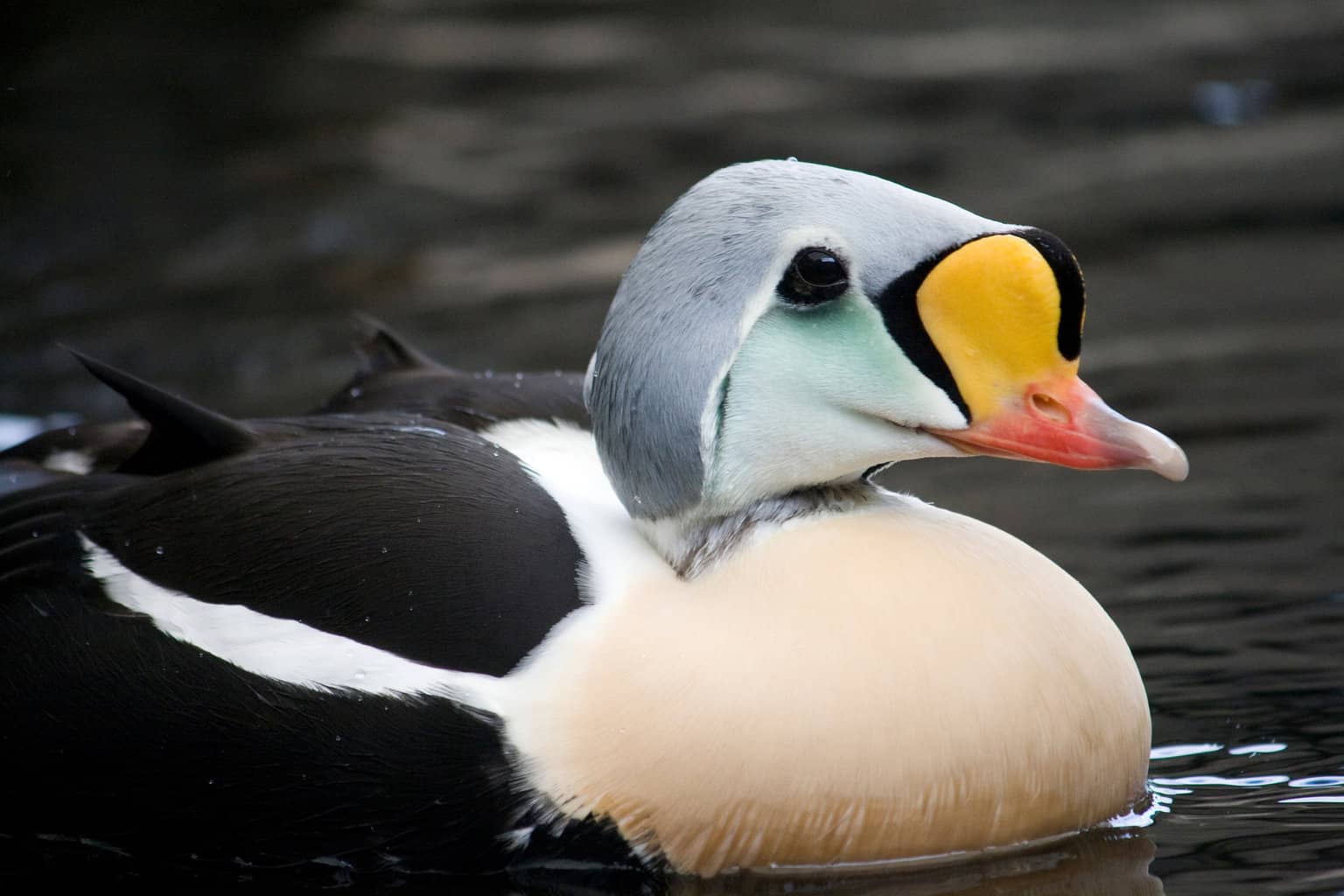
- Somateria spectabilis
- Length: 20 – 28 in (50 – 70 cm)
- Weight: 2.6 – 4.6 lb (1.2–2.1 kg)
- Wingspan: 34 – 40 in (86 – 102 cm)
Even though King Eiders usually don’t travel much further south than the Atlantic Coast of New England for the winter, some individuals have been documented traveling all the way to Florida during the winter.
The male King Eider is almost immediately identifiable, thanks to his oblong head and the large orange plate above his bright red bill that creates the appearance of a bulging forehead.
His body is black and white, and he has a light blue crown and a uniquely shaped head. It is oblong with a large orange plate above the bill, creating a bulging forehead. His bill is mostly bright red.
Female King Eiders don’t have such vibrant colors. They have a subdued, dark brown appearance with a pale cheek and neck. Her bill is all black instead of bright red.
Female King Eiders are more subdued, dark brown with pale brown areas, including the cheek and neck. The female’s bill is black.
These are traditional sea ducks that live exclusively in seawater. Your best chance of seeing them is among a group of other ducks, usually near a jetty or pier.
Lesser Scaup (Diving Duck)

- Aythya affinis
- Length: 15 – 18 in (38 – 49 cm)
- Weight: 40.77 oz (1155 g)
- Wingspan: 24 – 33 in (61 – 84 cm)
Lesser Scaup will arrive in Florida for the winter, often migrating alongside their close relatives, the Greater Scaup.
The male Lesser Scaup looks about the same as the Greater Scaup: iridescent green and purple head and gray and black bars over his body.
Females are dark brown, and they have a white face patch close to the base of their bill.
Although they are very similar in appearance, there is one easy way to tell Greater and Lesser Scaup apart. Lesser Scaup have a few “stray hairs” on their head, creating a tiny crest. Greater scaup have no such feathers.
The Lesser Scaup’s two best defense mechanisms are camouflage and playing dead.
Long-Tailed Duck (Sea Duck)

- Clangula hyemalis
- Length: 15 – 22 in (38 – 56 cm)
- Weight: 31.74 oz (900 g)
- Wingspan: 26 – 31 in (66 – 79 cm)
After breeding in the Arctic North, most Long-Tailed Ducks only migrate a short distance to spend the winter. Some will make their way to Florida, but they stay far off the coast and stay in the water.
They can dive up to 200 feet below the surface, and they show a strong preference for very deep waters.
The Long-Tailed Duck does something pretty fascinating, too. Both males and females completely reverse their coloring between breeding and non-breeding seasons.
We’re not talking about losing some of their bright coloring or unique markings in the winter. We’re talking about a true reversal of colors.
Any part of the male that is black during the breeding season will turn white that winter and anything that was white will turn black.
Females reverse their brown and white coloring.
Mallard Duck (Dabbling Duck)

- Anas platyrhynchos
- Length: 19.7 – 25.6 in (50 – 65 cm)
- Weight: 35.3 – 45.9 oz (1000 – 1300 g)
- Wingspan: 32.3 – 37.4 in (82 – 95 cm)
Mallards are, of course, one of the most common ducks in the world! They are incredibly populous in North America, and there are more Mallards in Florida than any other duck. They are mostly in the state for the winter.
Mallards forage for seeds and roots at night. When they defecate, they leave seeds throughout the wetlands, helping endangered plants to continue to exist and thrive.
Mallard pairs are frequent subjects of artwork, home decor, toys, and more. It is perhaps the easiest duck to recognize for most new birders.
- Squeeze, cuddle, repeat! Squishmallows are the softest, cutest plush toys around!
- Your new cuddle buddy awaits! Meet Avery the Mallard! Squishmallows have a style and personality all their own, encouraging fun...
- Snuggle up with the squishiest friend in town! These super soft, collectible plush toys make great cuddle companions! The squishy...
Last update on 2024-07-26 / Affiliate links / Images from Amazon Product Advertising API
Male Mallards are known for their iridescent green heads and the white ring on the neck. The male’s body is gray, and he has a blue speculum, yellow bill, and brown breast.
The female’s coloring is light and dark brown, and her head is dark brown. She has a black-tipped orange bill.
Masked Duck (Diving Duck)
- Nomonyx dominicus
- Length: 11.8 – 14.1 in (30 – 36 cm)
- Weight: 9.7 – 15.8 oz (275 – 450 g)
- Wingspan: 16.9 in (43 cm)
Masked Ducks prefer tropical environments, but a few vagrants make their way to Texas and Florida almost every year. These are very small ducks that don’t even weigh a pound!
Male Masked Ducks get their name from the black face mask that covers their eyes. The male’s body is rusty-brown, and he has a blue bill that is tipped in black.
Females have two dark stripes on their otherwise cream-colored faces. She is dark brown with a black bill.
As nighttime feeders, they are difficult to find and have been a challenge for researchers who want to study them. Currently, biologists believe that their diet is primarily made up of aquatic plants and seeds, but that they will also eat crustaceans and aquatic insects.
Mottled Duck (Dabbling Duck)

- Anas fulvigula
- Length: 18.5-21 inches
- Weight: 24.7-40.6 ounces
- Wingspan: 31.5-34.3 inches
There are very few differences between the male and female Mottled Duck. Both are streaked in light and dark brown. They have yellow bills and similar feather patterns.
The only significant differences between them are that the female is slightly less vibrant than the male, and her bill is slightly greenish.
They interbreed frequently with Mallard Ducks, and that has caused a decline in their overall population.
The Audubon Society explains: “Mottled Ducks are almost never seen in large flocks, generally traveling in pairs or small groups. A major threat to their survival is the release of numerous pet Mallards in Florida and elsewhere in the southeast; these feral birds interbreed with Mottled Ducks, diluting the wild population of the latter.”
They are rarely found outside of Florida, Louisiana, and Texas. However, they were introduced to South Carolina by duck hunters, and they are believed to have made their way into Florida.
They are most likely to be seen in marshes, ponds, and small lakes. They are even sometimes called the Florida Duck!
Muscovy Duck (Dabbling Duck)
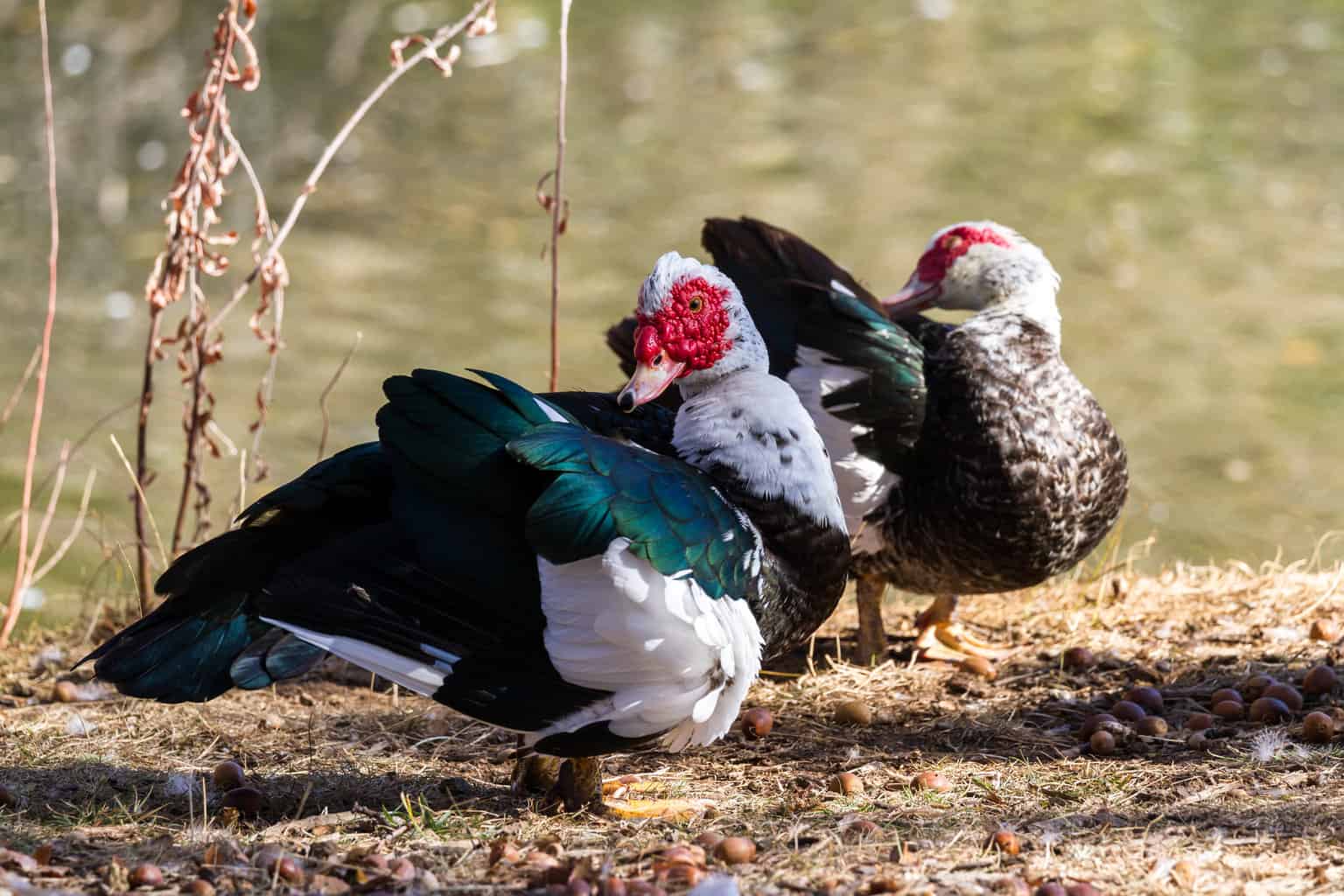
- Cairina moschata
- Length: 26 – 33 in (66 – 84 cm)
- Weight: 2.4 – 9.0 lb (1.1 – 4.1 kg)
- Wingspand: 54 – 60 in (137 – 152 cm)
Muscovy Ducks are considered invasive in Florida, as they compete with native ducks and cause damage to property. They also play a role in disease transmission.
There are many communities of Muscovy Ducks in Florida, including in cities like Jacksonville, Fort Lauderdale, Miami, Fort Meyers, West Palm Beach, Orlando, and Tampa.
Muscovy Ducks are huge. In fact, the male Muscovy Duck is North America’s largest and heaviest duck. The male is mostly black, but he has large white patches on his wings and red facial skin that is prone to growing large, irregular growths that look like warts.
Females are much smaller and more compact. They also have the same mostly black coloring with white patches.
Northern Pintail (Dabbling Duck)

- Anas acuta
- Length: 20 – 26 in (51 – 66 cm)
- Weight: 36.33 oz (1030 g)
- Wingspan: 29 – 35 in (74 – 89 cm)
Northern Pintails spend the winter in Florida, in both inland and coastal areas. They like shallow, muddy waters, including both fresh and brackish marshes. They often choose flooded fields and large lakes for their winter habitat.
Northern Pintail males get their name from their long, pointed tail feathers. Though they will have lost these long feathers in their fall molt before coming to Florida, they still have a pointed tail.
Their bodies are gray, white, black, and brown, with a dark brown head and a white stripe down their neck.
Females have a pointed tail that is shorter than the male’s tail. Her body is intricately patterned in shades of brown.
Northern Shoveler (Dabbling Duck)

- Spatula clypeata
- Length: 17.3 – 20.1 in (44 – 51 cm)
- Weight: 14.1 – 28.9 oz (400 – 820 g)
- Wingspan: 27.2 – 33.1 in (69 – 84 cm)
You will find Northern Shovelers in Florida during the winter. They will choose both freshwater and brackish marshes and ponds as their winter habitat.
Although the Northern Shoveler male has an iridescent green head that is similar to the Mallard, that is about where the similarities end. His thick, black, spatula-shaped bill is perfect for scooping up water and filtering his prey.
He has a gray body with brown sides and wings.
Females, on the other hand, have dark brown heads and light and dark brown bodies. The female has an orangeish-brown bill, and her legs are orange. Females will defecate on their own eggs to deter predators from going after their nests.
Red-Breasted Merganser (Sea Duck)

- Mergus serrator
- Length: 16 – 26 in (41 – 66 cm)
- Weight: 47.61 oz (1349 g)
- Wingspan: 31 – 35 in (79 – 89 cm)
You will find Red-Breasted Mergansers in Florida during the winter, mostly far off the coast in the deep waters of the Atlantic Ocean and Gulf of Mexico. Your chances of seeing one inland are almost zero. They fly at a pace of up to 81 miles per hour.
Red-Breasted Merganser males are shaggy-crested. They have a dark green head and a thick, white collar around the neck. They have gray, brown, black, and white markings on their bodies.
Females have a cinnamon-brown head and crest and a gray-brown body. Her throat is white.
Like other mergansers, they use their serrated bills to rip apart their prey, which includes small fish, tadpoles, aquatic insects, and crustaceans.
Redhead Duck (Diving Duck)
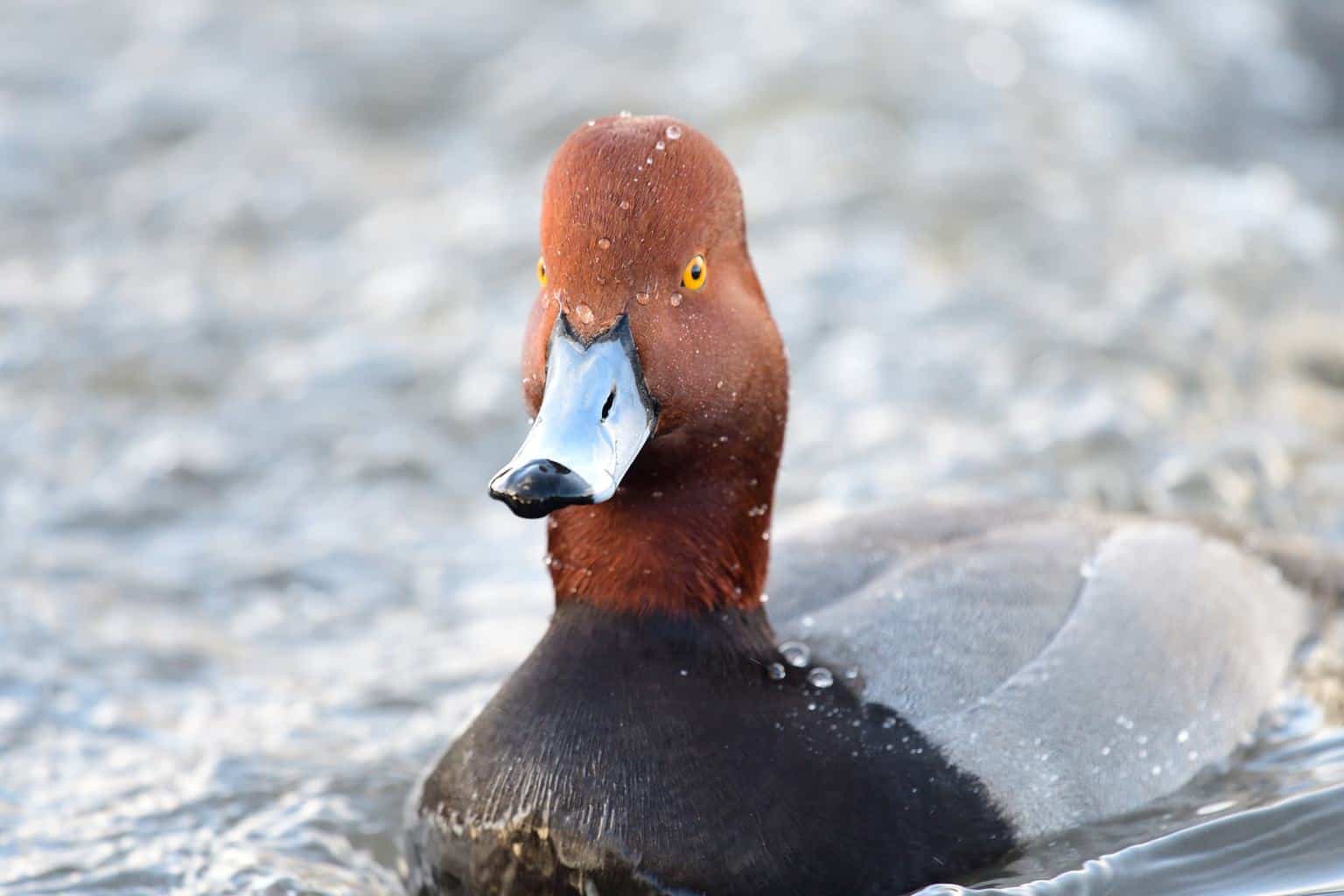
- Aythya americana
- Length: 18 -22 in (46 – 56 cm)
- Weight: 43.03 oz (1219 g)
- Wingspan: 29 – 35 in (74 – 89 cm)
Redhead Ducks are plentiful throughout Florida in the winter, including along the rivers near Tampa Bay and Charlotte Harbor.
They avoid forested areas and prefer deep waters for diving. They are prone to brood parasitism, especially when they live near Canvasbacks and can access Canvasback nests.
The male Redhead’s dark, reddish-brown head contrasts with his black chest and gray sides and back. He has a dark gray bill that is tipped with black.
Female Redheads are brown and lack discernable markings. Like male Redheads, females have black-tipped bills.
Ring-Necked Duck (Diving Duck)

- Aythya collaris
- Length: 14 – 18 in (36 – 46 cm)
- Weight: 32.09 oz (909 g)
- Wingspan: 24 – 30 in (61 – 76 cm)
The Ring-Necked Duck is a common winter resident throughout Florida’s small lakes and ponds. They are happy to inhabit cattle ponds, beaver ponds, and flooded agricultural lands, even though those tend to be shallower than the typical preferences of a diving duck.
Although the name Ring-Necked Duck implies a visible ring around the neck, the copper ring is nearly impossible to distinguish. Perhaps a better name would be the Ringbill, as they do have a white ring around the base of their bill, and a thick white band near the tip of the bill.
Despite their name, the copper ring on the neck of a Ring-Necked Duck is barely visible. You have to be incredibly close to the duck to see it. However, there is a ring around the male’s bill that stands out, and he also has a thin white outline around the base of his bill.
The rest of the male’s body is mostly black, including his chest, back, and head. His sides are gray.
The female Ring-Necked Duck is brown, and she lacks the white outline around the base of her bill. She does, however, have a white band near the end of her bill.
Ruddy Duck (Diving Duck)
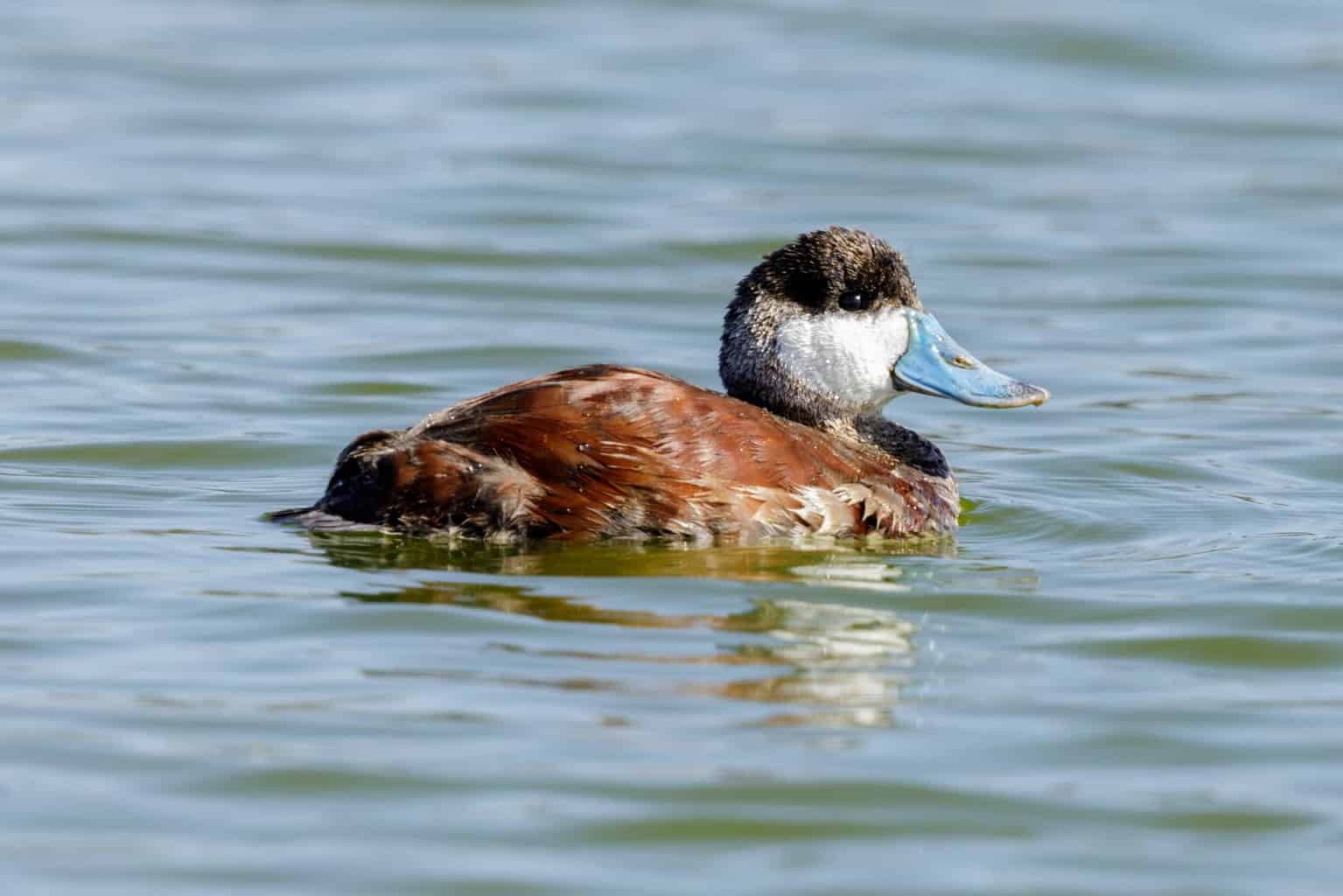
- Oxyura jamaicensis
- Length: 14 – 16 in (35.56 – 40.64 cm)
- Weight: 28.04 oz (795 g)
- Wingspan: 21 – 24 in (53 – 61 cm)
Breeding season sightings of Ruddy Ducks in Florida are incredibly rare, but they are common winter residents. They prefer well-protected estuaries and coastal marshes.
The male Ruddy Duck has very dark coloring in the summer, with a black head, brown body, and large white cheek patch. By the time he arrives in Florida for the winter, his coloring has faded to a dull gray. He has a broad, light blue bill year-round.
Female Ruddy Ducks are dappled brown and have a gray cheek patch. Her bill is black.
Surf Scoter (Sea Duck)
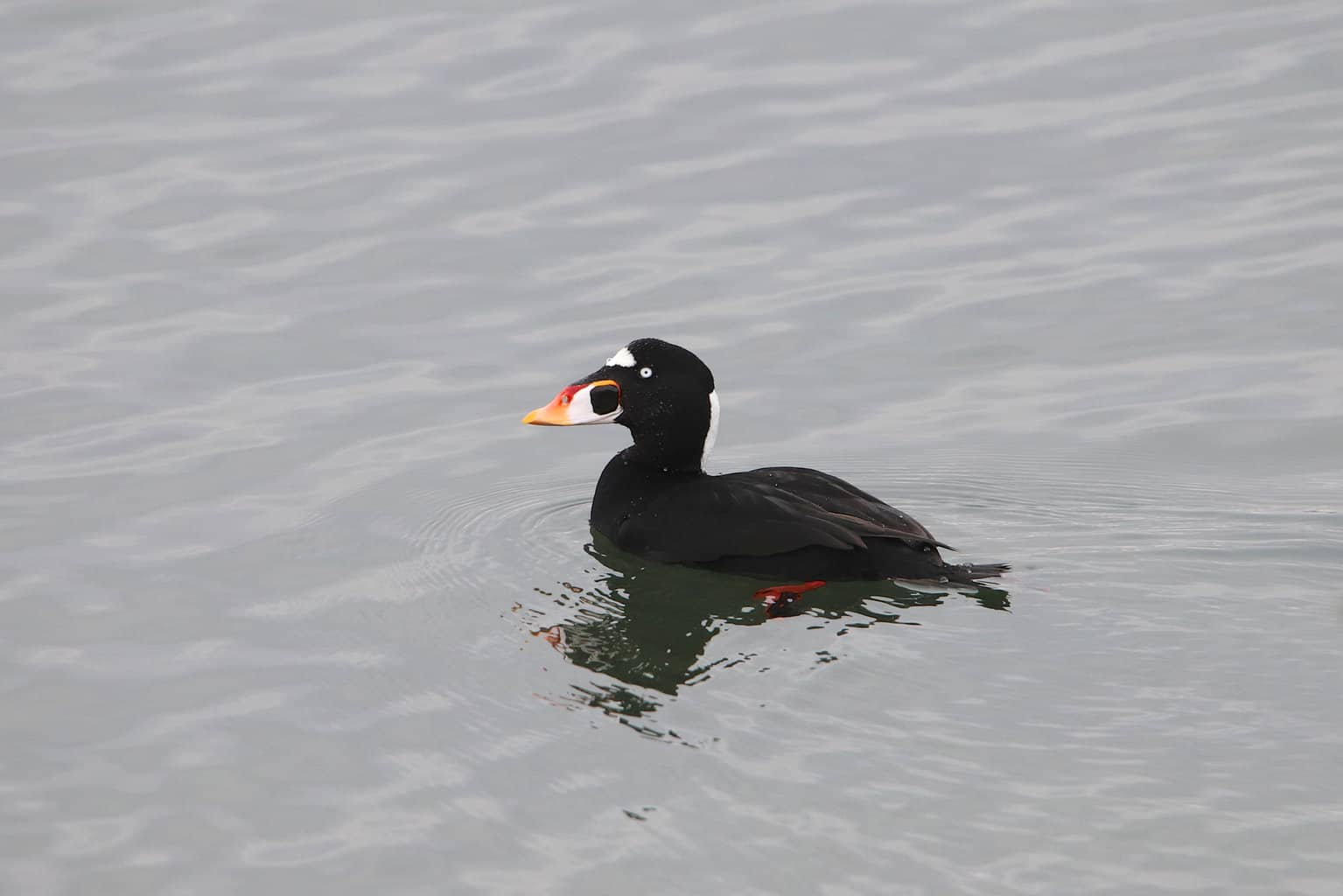
- Melanitta perspicillata
- Length: 17 – 21 in (43 – 53 cm)
- Weight: 35.27 oz (1000 g)
- Wingspan: 30 – 36 in (76 – 91 cm)
Surf Scoters can be found in two areas in Florida: along the northern coasts, and far from the land around the peninsula.
Surf Scoter males are mostly black and have sloping foreheads and a large bill that is brightly colored in orange, red, yellow, black, and white. He also has two white patches: one above his bill and another at the base of his neck.
Females are smaller and dark gray. They have a white patch on their neck and an additional patch behind each eye. Their bill is dark gray, which is noticeably different from the male’s colorful one.
White-Cheeked Pintail (Dabbling Duck)
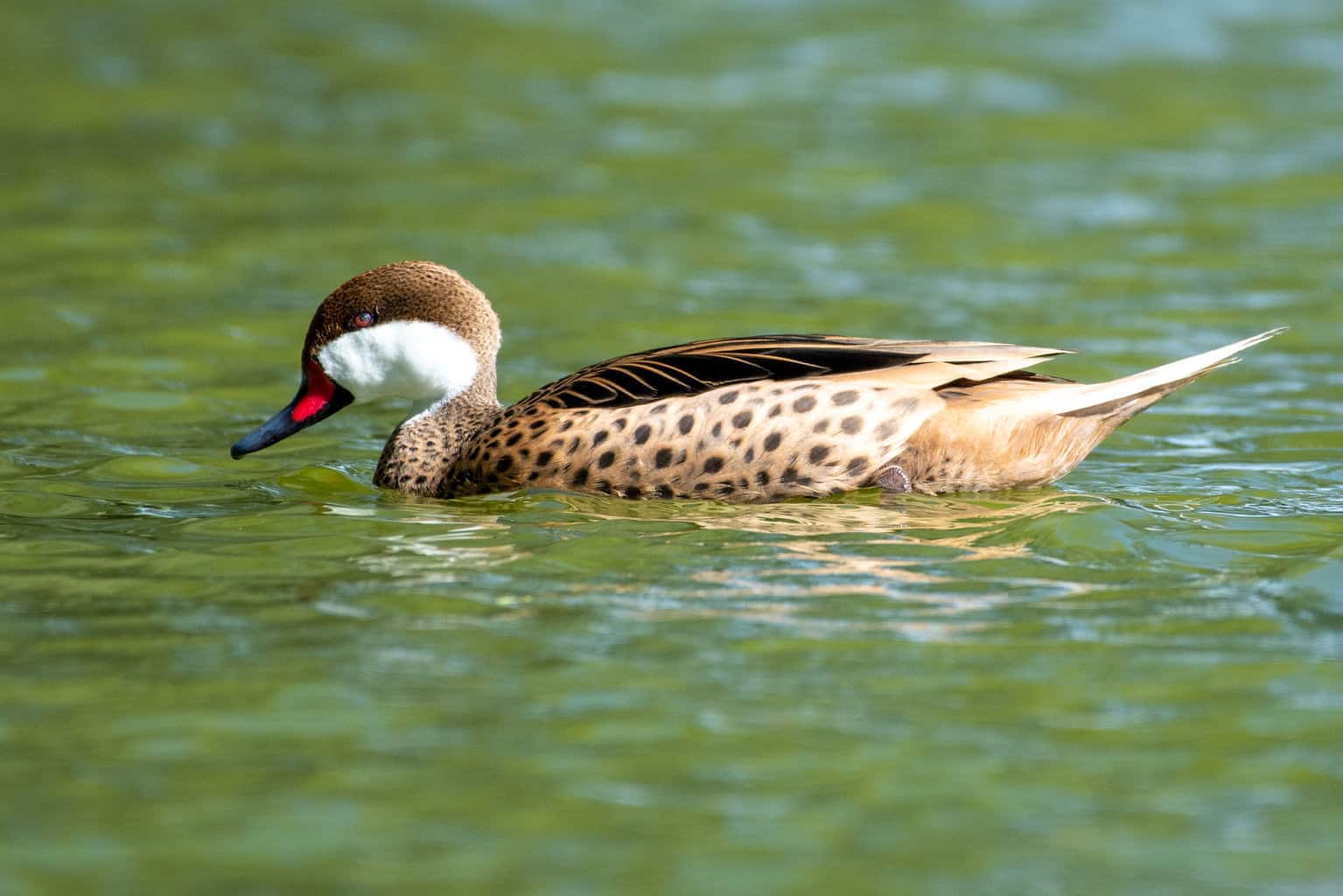
- Anas bahamensis
- Length: 22.8 – 25.5 in (58 – 65 cm)
- Weight: 17.7 – 20.7 oz (503 – 569 g)
- Wingspan: 23.6 – 26.7 in (60 – 68 cm)
White-Cheeked Pintails are year-round residents of the Caribbean Islands, and they are considered accidental vagrants in Florida.
To qualify as a pintail, a duck must have a long, pointy tail, especially during the breeding season. White-Cheeked Pintails qualify and earn the rest of their name from their bright white cheeks.
Males and females look almost identical, and their appearance is somewhat similar to the female Northern Pintail. Their bill is part black, part orange.
They inhabit freshwater and saltwater habitats.
White-Winged Scoter (Sea Duck)

- Melanitta deglandi
- Length: 19 – 24 in (48 – 61 cm)
- Weight: 62.4 oz (1768 g)
- Wingspan: 33 – 41 in (84 – 104 cm)
Most of Florida will never see White-Winged Scoters, but there are usually some that spend the winter in the waters near Pensacola and Jacksonville.
Male and female White-Winged Scoters look a lot alike. They both have dark bodies, but the male is just slightly darker than the female.
Their bills are thick. Some small markings on their faces are different from one another, too. The male has a white comma shape over his eyes, and the female has a small white patch on each cheek.
The biggest difference between the male and female is that the female’s bill is all black, whereas the male’s is red from the halfway point forward.
Wood Duck (Dabbling Duck)
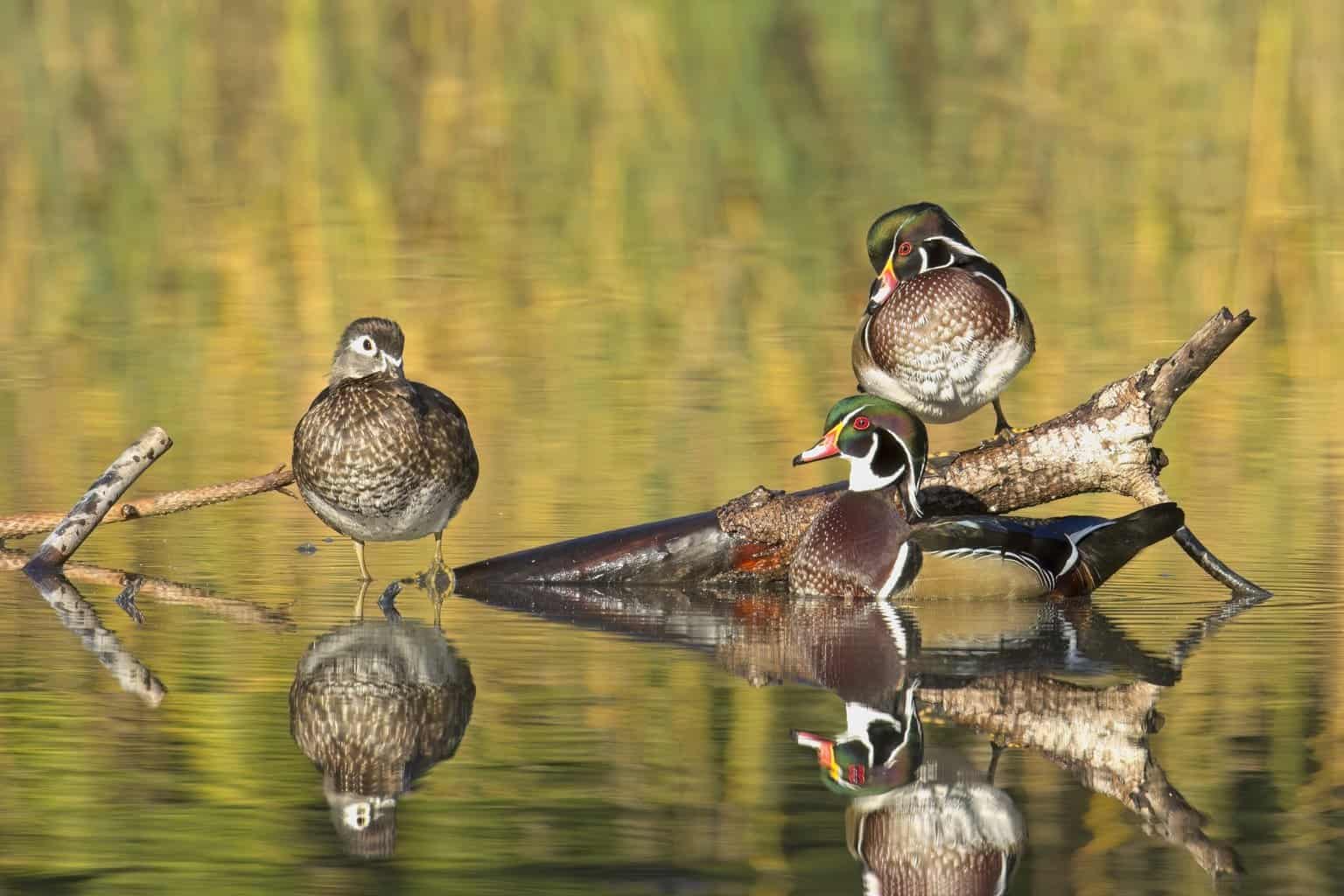
- Aix sponsa
- Length: 18.5 – 21.3 in (47 – 54 cm)
- Weight: 16.0 – 30.4 oz (454 – 862 g)
- Wingspan: 26.0 – 28.7 in (66 – 73 cm)
Wood Ducks are common residents in Florida all year-round. Even more Wood Ducks arrive for the winter. During the summer, they nest in tree cavities in close proximity to wetlands, rivers, ponds, and lakes. During the winter, they still prefer areas with lots of vegetation.
The male Wood Duck is vibrant and colorful. He has brown sides, a chestnut brown breast, an iridescent green head, and a long crest on the back of his head. He is also striped in white all over his body, and his bill is multi-colored with white, black, orange, and yellow areas.
Females have a much smaller crest. She has a gray head and brown body, and her eyes are outlined in white.
Ready to Find Ducks in Florida?
We hope you find this list helpful as you look for ducks in Florida!
Whether you’re preparing to find interesting ducks in your area or you came to this list to identify a duck that you found, we hope you find and document many more intriguing and attractive Florida ducks.
And while you’re identifying the many different kinds of ducks in Florida, don’t forget to take a look at our Bird Guide for Florida, with 26 different and fascinating bird species!
Have fun birding in the Sunshine State!

